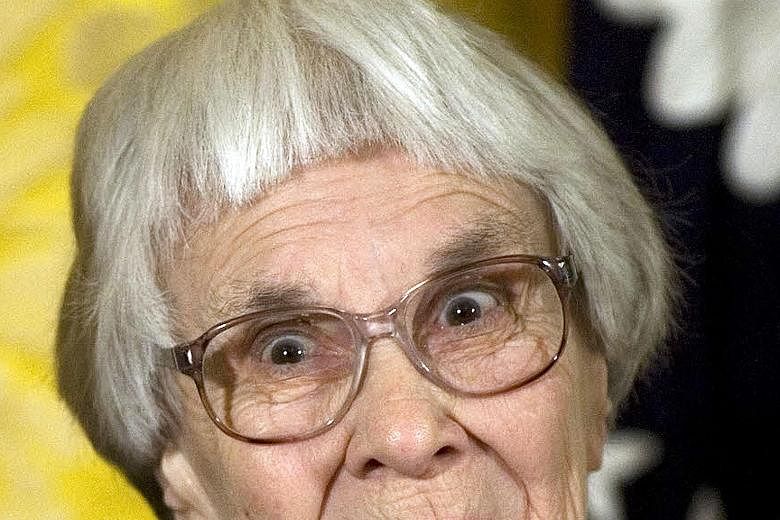NEW YORK • When the nowdefunct publisher J.B. Lippincott bought Harper Lee's Go Set A Watchman in 1957, the novel fell into the hands of Therese von Hohoff Torrey - known professionally as Tay Hohoff - a small, wiry veteran editor in her late 50s.
Hohoff was impressed.
"The spark of the true writer flashed in every line," she would later recount in a corporate history of Lippincott.
But as she saw it, the manuscript was by no means fit for publication.
It was, as she described it, "more a series of anecdotes than a fully conceived novel".

In the next couple of years, she led Lee from one draft to the next until the book finally achieved its finished form and was retitled To Kill A Mockingbird.
The publication of Watchman offers a rare glimpse at the before and after of a book widely regarded as a masterpiece.
The main characters may be the same, but Watchman is an entirely different book in both shape and tone from Mockingbird.
The release of the lightly copy- edited book also leads inevitably to the question: Who was the invisible hand guiding Lee as she transformed this book into Mockingbird? How big a role did she play in reconceiving the story from a dark tale of a young woman's disillusionment with her father's racist views, to a redemptive one of moral courage and human decency?
Publishing lore is filled with stories of famously headstrong editors imposing their will on authors.
But Hohoff, who died in 1974 aged 75, was in a different mould.
"I suffer from some sort of mother-complex, so that I always want to make paths smooth for the people I am fond of and of whom I have a high opinion," she wrote in 1969 in a letter to Edward Burlingame, who was at that time the new executive editor of Lippincott.
"She was closely attentive and tough, but I never felt manhandled by her," Nicholas Delbanco, who worked with her as a young author in the late 1960s, said recently in an interview.
But by all accounts, Hohoff, a chain-smoker with a deep, gravelly voice, was also a strong-willed and forceful editor.
She cut Delbanco's second novel, Grasse 3/23/66, from 500 pages to less than 200 - an effort for which Delbanco remains grateful.
Signs certainly point to a close collaboration and intimate relationship between her and Lee.
Lee had lost her mother, who suffered from mental illness, six years before she met Hohoff. Like many unpublished authors, Lee was unsure of her talents.
"I was a first-time writer, so I did as I was told," Lee said in a statement this year about the evolution from Watchman to Mockingbird.
Hohoff offers a more detailed characterisation of the process in the Lippincott corporate history: "After a couple of false starts, the storyline, interplay of characters, and fall of emphasis grew clearer, and with each revision - there were many minor changes as the story grew in strength and in her own vision of it - the true stature of the novel became evident."
There appeared to be a natural give and take between author and editor. "When she disagreed with a suggestion, we talked it out, sometimes for hours," Hohoff wrote. "And sometimes she came around to my way of thinking, sometimes I to hers."
Raised in a multi-generational Quaker home near Prospect Park in Brooklyn, Hohoff attended a Quaker school, Brooklyn Friends. Such an upbringing suggests certain progressive values.
She joined Lippincott in 1942. Eventually she became a senior vice- president at the company.
At the time, it was rare for a woman to have such a senior editorial position at a major publishing house. It appeared, though, Hohoff comfortably inhabited the role.
"She was a powerful lady who knew her own mind and spoke in a frank sort of way," Burlingame said recently.
With Lee, it is clear that Hohoff provided more than just editorial guidance. One winter night, as Charles J. Shields recounts in Mockingbird: A Portrait Of Harper Lee, Lee threw her manuscript out her window , before calling Hohoff in tears. "Tay told her to march outside immediately and pick up the pages," Shields writes.
After Mockingbird, author and editor remained close. When Lee found a 12-toed kitten huddled against a pipe in the basement of her apartment building, she brought it to Hohoff and her husband in a wicker basket.
"He needed a home," Hohoff wrote in a memoir about her pets, Cats And Other People. "She knew us very well and pulled out all the right stops."
Year after year, she tried to gently coax a second book out of Lee, who is known also as Nelle among close friends, while at the same time fending off her impatient colleagues.
"Lippincott's sales department would have published Harper Lee's laundry list," Burlingame said. "But Tay guarded Nelle like a junkyard dog. She was not going to allow any commercial pressures to put stress on her to publish anything that wouldn't make Nelle proud. It was a decision we all supported."
NEW YORK TIMES

